
 |
Inside Bootham BarPhotographed on 16 March 2004 |
|
Bootham Bar is one of our gateways to the city. Though I look at it often from the outside, I've never paid much attention to the inside of it. I ended up taking some photos of the inside because a large group of tourists were in front of me on the walls and I had to wait for them to move on, so skulked about here for a while. Shown left – from the inside of the bar, looking out through the entrance to the walls walkway. I noticed for the first time, looking at this photo, how the centre of the steps is worn smooth. |
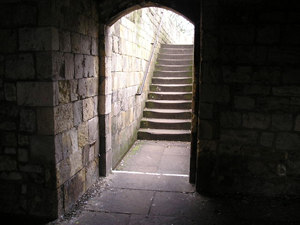 |
|
|
Bootham Bar is on the site of the north-western gateway of Roman Eboracum, though the present bar is of medieval construction. Like all the gates and walls of the city, it has undergone extensive restoration work over the years, after early-19th-century plans to demolish the gates and bars were abandoned, and we decided to keep our walls after all. Unfortunately several of the barbicans had already been demolished, including the one on this bar. Now, in 2004, York citizens are once again campaigning to Save our Barbican, but the Barbican in question is a leisure facility. (Personally I think it's the worst venue for music I've ever been to, and a strangely depressing place, but I must have missed its charms.) |
|
|
Again inside the bar, looking out the other way towards St Leonard's Place. The wall used to continue from here too, and a small section of it remains at the end of the buildings on St Leonard's, but the rest had fallen into disrepair and was demolished to create St Leonard's Place. In Exhibition Square, just across this new road, is a statue of William Etty, who was one of the first to protest against the authorities' plans to demolish this historic gateway.
|
|
The outside of this gateway is often photographed, the inside less often. This might be because of the pigeons, who seem to have taken up residence. There are a number of openings that allow them easy access. The image below shows the view I took along High Petergate, from one of them. All the while watched by the pigeons, who sit in the bar all day, and watch tourists and residents passing. |
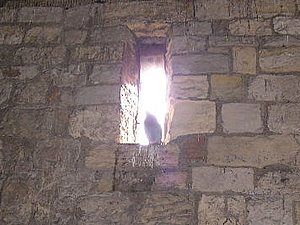 |
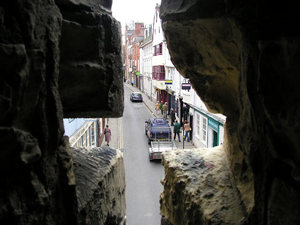 |
'In 1501 it was ordered that a great door knocker should be fixed to
the oak doors of Bootham Bar and that "Scottish persons who were
wishful to enter York should knock first." (I can assure our friends north of the border that they don't have to knock.) |
|
The power of public protest in the fight to conserve our heritage is well-known now, but we should admire those who, at the beginning of the 19th century, campaigned to stop the planned demolition of the city walls. A public meeting was held in a local tavern in 1832 in which the citizens' outrage was made known to the authorities. Though the plan to demolish the walls was abandoned, citizens continued to watch over them. In 1889, during repair work here, a lone protestor stepped in to stop mutilation of the portcullis (photo, right). |
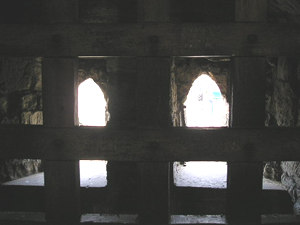 |
|
|
Partly because of pigeon droppings, and partly because of even messier humans, the inside of Bootham Bar is actually quite dirty and grim. This might shock the tourists I guess, but at least you could say it's probably more authentically "medieval". Not authentically medieval though is the wrapping from a box of beer (below right). In the early 19th century it was also a bit mucky. Hugh Murray points out that the residents of Clifton were complaining that the bar's barbican (later removed) was 'not fit for any female of respectability to pass through' because of the droppings of animals on the way to cattle market and its use as a urinal by passers-by.' Mmm. Even with the Barbican removed, some things haven't changed then. |
|
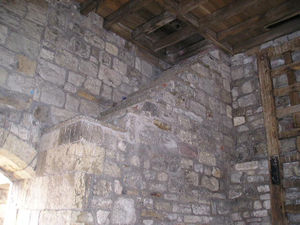 |
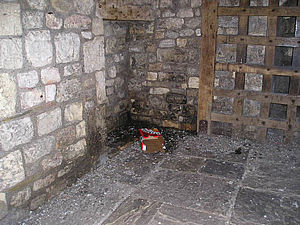 |
|
As a contrast to the above, please meet the butterfly I met on the steps as I left the bar to follow the walls walk. The butterfly told me it must be spring. The walk along the walls from here is recorded in two separate pages. Gillygate gardens and Minster precincts, or, if you'd like less of a horticultural slant – Bar walls: Bootham Bar to Monk Bar. |
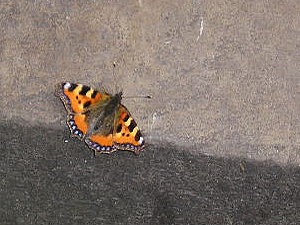 |
|
Or, if you'd rather get away from these often rather busy bars and walls, nearby are the streets of St Leonard's Place, Bootham, and Gillygate, all photographed in later walks during the summer months (York Walks /3). |
|